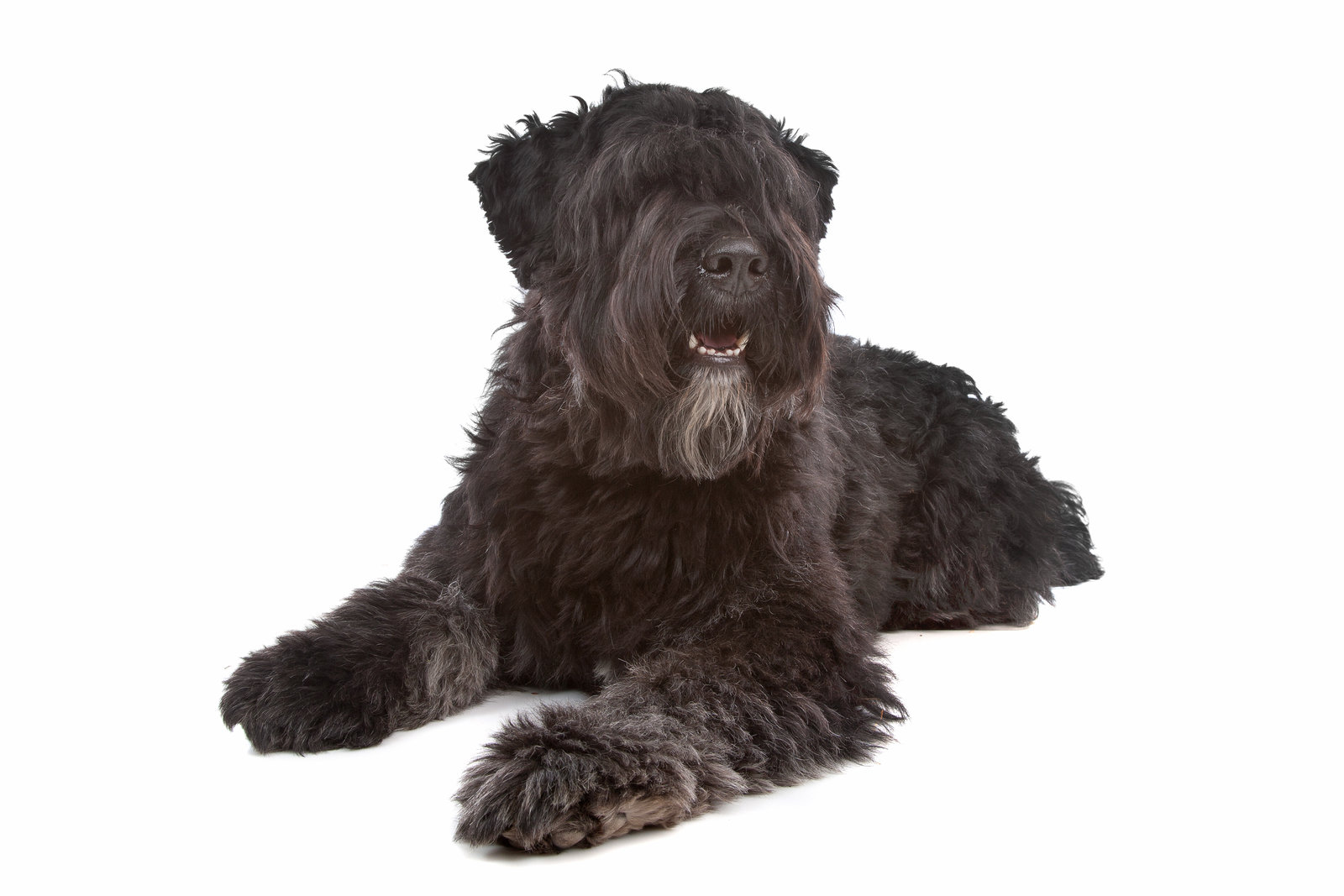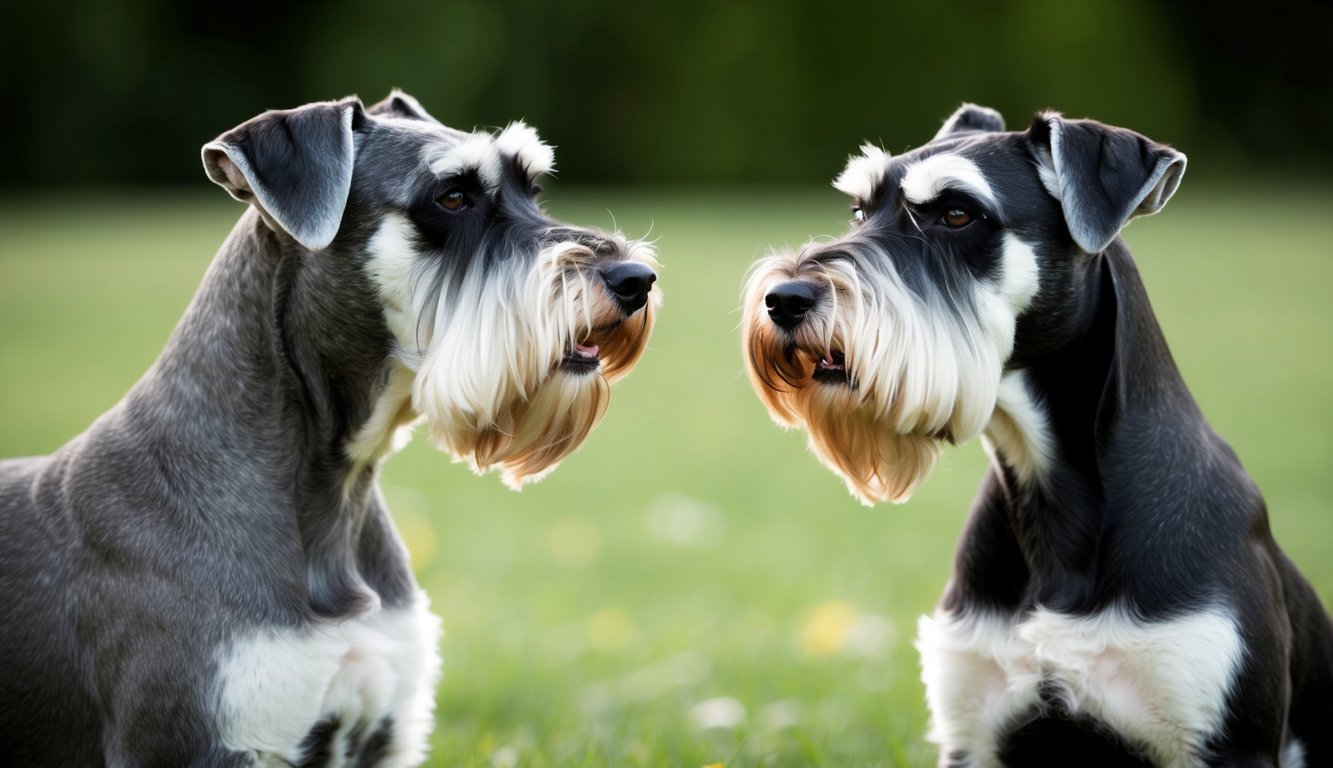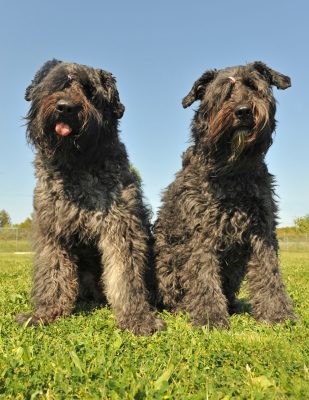The Bouvier des Flandres and Giant Schnauzer have distinct European origins. Both breeds were developed for working purposes, but in different countries and environments. But there’s much more to these two dog breeds. Let’s explore them below!
If you’re still on the market to buy a Bouvier des Flandres or Giant Schnauzer, PuppySpot currently offers a $300 discount using the code PUPPY300, just click the banner below!
Physical Characteristics
The Bouvier des Flandres and Giant Schnauzer are both large, powerful breeds with distinct physical features. Their size, coat types, and colors set them apart from other dogs.
Size and Weight Comparison
- Bouvier des Flandres males stand 24.5 to 27.5 inches tall at the shoulder, while females are 23.5 to 26.5 inches. Giant Schnauzers are slightly taller, with males reaching 25.5 to 27.5 inches and females 23.5 to 25.5 inches.
- Bouviers weigh between 70 to 110 pounds for males and 60 to 80 pounds for females. Giant Schnauzers are similar, with males weighing 65 to 90 pounds and females 55 to 75 pounds.
- Both breeds are sturdy and muscular. They have a square build with a strong, broad chest. Their powerful bodies make them well-suited for work and various activities.
Coat Types and Grooming Requirements
- Bouviers have a thick, rough double coat that needs regular brushing. Their outer coat is coarse and shaggy, while the undercoat is soft and dense. They need trimming every 6-8 weeks.
- Giant Schnauzers have a wiry, harsh outer coat with a soft undercoat. They require daily brushing and regular trimming. Both breeds are considered low-shedding and somewhat hypoallergenic.
- Regular grooming is key for both breeds. This includes nail trimming, ear cleaning, and dental care. Professional grooming may be needed to maintain their coat’s proper texture and appearance.
Distinctive Breed Colors
Bouviers des Flandres come in various shades of fawn and brindle. Common colors include:
- Fawn
- Black
- Salt and pepper
- Gray
- Brindle
Giant Schnauzers have a more limited color range:
- Solid black
- Salt and pepper
Both breeds may have small white markings on their chest. The Bouvier’s coat often appears tousled, giving them a rugged look. Giant Schnauzers have a neater appearance with their wiry coat and distinctive beard and eyebrows.

Temperament and Personality
The Bouvier Des Flandres and Giant Schnauzer have unique personality traits that set them apart. Both breeds are known for their protective nature and strong bonds with family members. Let’s explore their temperaments in more detail.
Understanding the Protective Nature
- Bouvier Des Flandres and Giant Schnauzers are highly protective of their families. They have a natural instinct to guard their homes and loved ones.
- Bouviers are calm and steady, but always alert. They’ll quickly respond to potential threats. Giant Schnauzers are more energetic and may react more intensely to perceived dangers.
- Both breeds need early socialization and training to manage their protective instincts. This helps them distinguish between real threats and normal situations.
Affection Levels and Social Needs
- Bouviers and Giant Schnauzers form strong bonds with their families. Bouviers are generally more reserved in showing affection. They prefer to be near their owners but may not seek constant physical contact.
- Giant Schnauzers are often more demonstrative. They enjoy being close to their family and may follow their owners from room to room.
- Both breeds need quality time with their families. Regular interaction, play, and training sessions help meet their social needs. Without enough attention, they may become anxious or develop problem behaviors.
Stranger-Friendly or Territory Guarding?
- Neither breed is typically very friendly with strangers. They tend to be aloof and wary of unfamiliar people.
- Bouviers are usually calmer when meeting new people. They’ll observe before reacting. Giant Schnauzers may be more vocal and assertive towards strangers.
- Both breeds make excellent watchdogs. They’ll alert their owners to any unusual activity. With proper socialization, they can learn to accept visitors approved by their family.
- Consistent training is key to managing their territorial instincts. This ensures they remain protective without becoming aggressive.
Training and Intelligence
The Bouvier des Flandres and Giant Schnauzer are smart, trainable breeds. Both excel in many tasks due to their working dog heritage. Their intelligence makes them quick learners, but they need firm, consistent training.
Trainability and Learning Curve
Bouvier des Flandres dogs are eager to please and quick to learn. They respond well to positive reinforcement. Their strong will means they need an experienced owner who can be patient and consistent. Giant Schnauzers also learn fast. They have a natural desire to work and enjoy mental challenges. Early socialization is key for both breeds to prevent stubbornness.
Both breeds can be trained for various roles, including:
- Guard dogs
• Police work
• Search and rescue
• Herding
Intelligence Rating Across Dog Sports and Work
Bouvier des Flandres and Giant Schnauzers rank high in canine intelligence tests. They excel in obedience, agility, and other dog sports. The Bouvier shines in herding trials due to its farm dog roots. Giant Schnauzers often do well in protection sports like Schutzhund.
Both breeds have served as:
- Military dogs
• Police K9s
• Therapy animals
Their high intelligence and willingness to work make them valuable service dogs. They can assist people with disabilities, autism, or PTSD. In competitive obedience, both breeds regularly earn top scores. Their quick thinking and focus help them master complex commands.
Health and Longevity
The Bouvier Des Flandres and Giant Schnauzer have some similar health concerns, but differ in lifespan and exercise needs. Both breeds require regular vet checkups and a healthy lifestyle to thrive.
Common Breed-Specific Health Issues
Hip dysplasia and elbow dysplasia are issues that affect both breeds. These conditions can cause joint pain and mobility problems.
Bouviers may develop:
• Cataracts
• Glaucoma
• Heart problems
Giant Schnauzers are prone to:
• Bloat
• Cancer
Both breeds can experience allergies and skin issues. Regular grooming helps prevent skin problems in their thick coats.
Average Lifespan and Influencing Factors
The Bouvier Des Flandres typically lives 10-12 years. Giant Schnauzers have a slightly longer average lifespan of 12-15 years.
Factors affecting longevity:
• Diet quality
• Exercise
• Genetic health
• Regular vet care
Proper nutrition and weight management are key for both breeds. Owners should feed high-quality dog food suited to their size and energy needs.
Obesity and Exercise Needs
- Both breeds have high energy levels and need plenty of exercise to stay healthy. Daily walks, playtime, and mental stimulation are essential.
- Giant Schnauzers are especially energetic. They require at least 60-90 minutes of exercise per day. Bouviers need slightly less, around 45-60 minutes daily.
- Without enough activity, these large breeds can become overweight. Obesity raises their risk for joint problems, heart disease, and diabetes. Regular exercise helps maintain a healthy weight and provides mental stimulation.
Activity Requirements and Lifestyle Adaptability
Bouviers des Flandres and Giant Schnauzers are active breeds with specific exercise needs. Their adaptability to different living situations varies.
Exercise and Playfulness
Both breeds need plenty of daily exercise. Giant Schnauzers and Bouviers des Flandres have similar activity levels. They enjoy long walks, runs, and playtime. Giant Schnauzers are very playful. They like games and interactive toys. Bouviers are also playful but may be more laid-back.
These dogs need at least 60 minutes of exercise per day. Activities can include:
- Jogging
- Hiking
- Fetch
- Agility training
Without enough exercise, both breeds may become destructive or develop behavior issues.
Compatibility With Apartment Living
- Giant Schnauzers and Bouviers des Flandres can adapt to apartment living if their exercise needs are met. However, they do better in homes with yards.
- Bouviers may adapt slightly better to smaller spaces. They tend to be calmer indoors. Giant Schnauzers have more energy and may be restless in small areas.
- Both breeds need mental stimulation. Puzzle toys and training sessions help keep them content in apartments. Regular outdoor trips are crucial for their well-being in any living situation.

Care and Maintenance
Caring for Bouvier Des Flandres and Giant Schnauzers requires dedication. Both breeds have specific needs for grooming, diet, and dental health. Proper care ensures these large dogs stay healthy and happy.
Grooming Needs and Shedding
- Bouvier Des Flandres have thick, shaggy coats that need regular brushing. They shed moderately and require professional grooming every 6-8 weeks. Daily brushing helps prevent matting.
- Giant Schnauzers have wiry double coats. They need brushing 2-3 times a week and professional grooming every 6-8 weeks. Their coats shed minimally but require hand-stripping for show dogs.
- Both breeds need regular nail trims, ear cleaning, and baths as needed. Grooming sessions are a good time to check for skin issues or abnormalities.
Feeding Regimen and Weight Management
- Bouvier Des Flandres and Giant Schnauzers are large, active breeds. They need high-quality dog food formulated for large breeds. Adult dogs typically eat 3-4 cups of food daily, split into two meals.
- Portion control is important to prevent obesity. Owners should adjust food amounts based on the dog’s activity level, age, and weight. Regular weigh-ins help monitor their condition.
- Fresh water should always be available. Treats should make up no more than 10% of their daily calorie intake.
Addressing Potential Dental Diseases
- Both breeds can be prone to dental issues. Regular tooth brushing is essential, ideally daily but at least 2-3 times a week. Use dog-specific toothpaste and brushes.
- Dental chews and toys can help reduce plaque buildup. Regular vet check-ups should include dental exams. Professional cleanings may be needed annually.
- Signs of dental problems include bad breath, red or swollen gums, and difficulty eating. Early detection and treatment of dental diseases can prevent more serious health issues.




